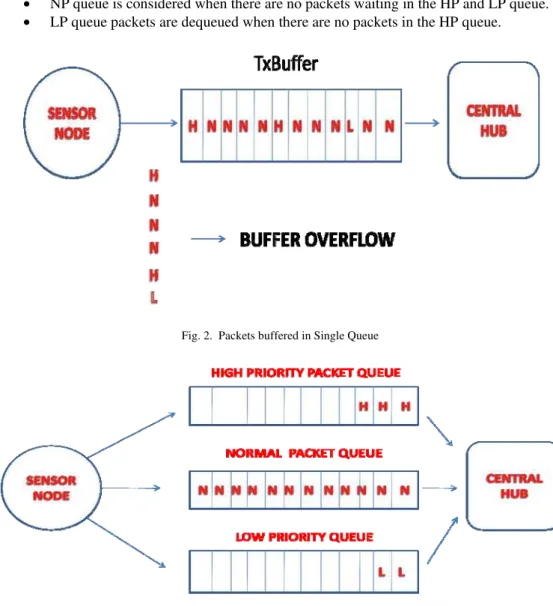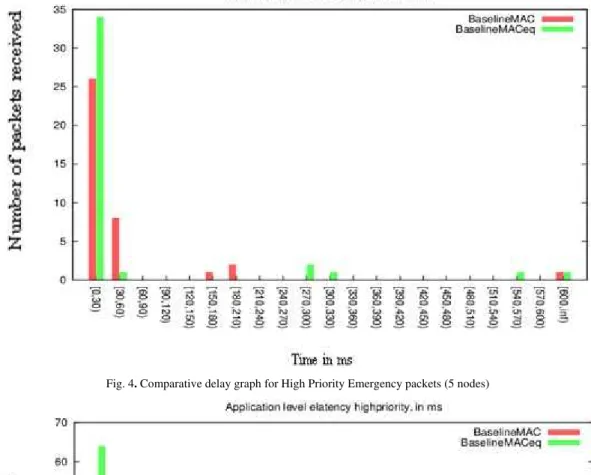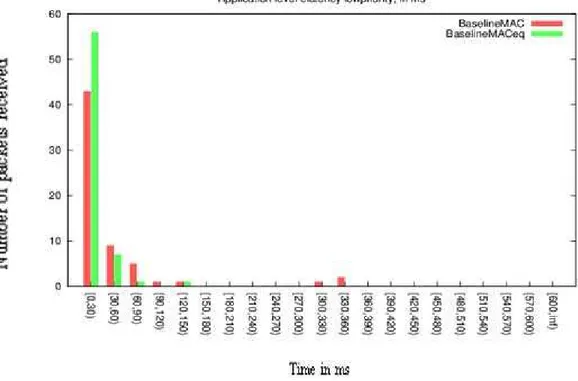Queuing Based Emergency Handling in
WBAN
Muthulakshmi. A#, Shyamala. K*,
#
Department of Computer Science, MOP Vaishnav College For Women, Nungambakkam, Chennai – 600 034, Tamil Nadu.
*
Department of Computer Science, Dr. Ambedkar Government College, Vyasarpadi, Chennai – 600 039, Tamil Nadu.
muthulakshmi.res@gmail.com shyamalakannan2000@gmail.com
Abstract - Wireless Body Area Network (WBAN), a network of sensor nodes placed in and around human body to monitor the patient’s health condition remotely in their day to day routine life without the person being in the hospital environment is the most envisioned area of WSN research. The main objective of WBAN is to deliver the patient’s vital signs during the emergency conditions with minimum time delay and maximum reliability. The emergency packets generated by sensor nodes in WBAN during such emergency situation should be provided prioritized service. This paper discusses a multiple Queuing technique to minimize the time delay of emergency packets. The emergency situation is phased based on the threshold value of the parameter being measured which results in high priority and low priority packets. Three types of packets generated by the nodes are prioritized in the following order, High Priority packets, Low priority packets and Normal packets. Simulation studies with varying number of nodes shows that nearly 90% of the low priority packets and 85% of the high priority packets are delivered within 30ms time delay with multiple queuing mechanism as compared to 60% (high priority packets) and 58% (low priority packets) with single queue.
Keyword – WBAN, Queuing, delay, emergency packets, priority. I. Introduction
The rapid advancements in the field of miniature devices and wireless technology have opened many avenues for various applications of Wireless sensor networks. Wireless Body Area Networks (WBAN) is one of the widely researched applications of WSN which makes health care services patient friendly [1]. WBAN consists of small devices called sensors in and around the human body and connected to the central hub (Network Co-ordinator) through wireless link. These sensor nodes measure certain parameters of the human body like heart rate, body temperature, electrocardiogram and send it to the hub which in turn sends it to the medical database through WAN/LAN or internet. This helps the medical practitioners to monitor the patient condition remotely. A WBAN finds other applications like assistance for the disabled, public safety (firefighters, policemen, military environment) and being embedded in appliances such as microphone, camera, advanced human computer interface etc., [2-4].
The functions of any network are managed by the layered protocol stack with each layer having a specific set of functions. The techniques and protocols of WSN cannot be followed for WBAN as it has its own constraints. WBAN has the following constraints as compared to WSN [5].
• The devices used in WBAN are very small with form factor of the order of 10-3 which poses constraints on the available energy resources, processing power and memory.
• Every sensor node in WBAN has a specific function without any redundancy. • Transmission between the nodes takes place in the lossy medium i.e human body.
• Data transmission with high reliability and low delay is prime goal of communication in WBAN as it involves medical data.
• WBAN should ensure proper security mechanism as it involves private and confidential medical data. • Each sensor node in WBAN is intended to measure different parameter which places heterogeneous
requirement on the data rate, energy consumption and other QoS parameters.
technique, Section 4 discusses the simulation study and results Section 5 gives the mathematical analysis and Section 6 concludes the paper.
Fig.1. A Wireless Body Area Network System
II. Literature Review
WBAN is designed with the goal to deliver the vital signs of the body without any delay and loss, otherwise it could prove fatal to patient’s life. Communication protocols designed for WBAN should be able to achieve this goal to make it more efficient. Considering the randomness in the generation of emergency signals, they need to be handled in the more dynamic way. There are many protocols that prioritise the transmission of emergency packets. Kateretse et al proposes a traffic scheduling scheme where packets generated by the sensor nodes are stamped as normal, moderate and urgent based on how much they differ from the threshold value using the critical table and schedules them to different priority queues. As this scheduling happens only in the Hub, they undergo some delay in their node buffers [7]. Mohsin Iftikhar et al give an analytical model for a WBAN system where different classes of bursty traffic are being placed in various priority queues. Three different priority queues are handled in this paper but again they concentrate only on bursty traffic not on individual packets[8]. Rashwand et al proposes a model that bridges WBAN (IEEE 802.15.6) and WLAN (IEEE 802.11e EDCA) where the eight different user priorities are mapped to four different Access Categories each having different Queues. The service differentiation is achieved by varying parameters like Arbitrary Inter-Frame Space (AIFS), Contention Window backoff and Transmission time (TXOP) [9]. Salam, Abdul, et al has designed a class based Qos model with three different classes and the priority of the packets are set by the classifier at the sink based on the information from the sensor node [10].
III. Emergency Handling in WBAN
Sensor nodes in WBAN measuring various parameters generates packets of different sizes, different rates with varying QoS requirements depending upon the type of parameters being measured or with varying scenarios. Hence an efficient WBAN should provide real time and reliable transmission with service differentiation [10]. Also when the measured parameters shows alarming values during patient's critical situation, packets generated during such emergency situations carrying life critical data should reach destination with minimum delay and maximum reliability. Any loss in emergency packet or delayed reception can prove fatal to the patient. This situation can be handled by prioritizing packets generated by the sensor nodes. Packets generated when the measured parameter is greater than or equal to the threshold value can be termed as emergency packets and these packets are stamped as high priority packets. Reception of these packets instigates emergency treatment for the patient. As the main advantage of WBAN is remote patient monitoring, administering emergency treatment to the patient can be guaranteed by sending emergency packets of increasing priorities based on the how much the parameter exceeds the threshold value. This ensures that remote monitoring stations or medical practitioners are intimated about the patient’s emergency condition before the situation becomes highly critical (alarming). Thus sensor nodes in WBAN generates three type of packets namely
• High Priority Packets (HP) • Low Priority Packets (LP) • Normal Packets (NP)
desirable and prioritisation losses its purpose. Hence each node is considered to have three different queues to place three different categories of packets. (No. Of HP and LP packets are much less than the Normal packets as they are generated only during emergency situation.)
• HP Queue with High Priority packets. • LP Queue with Low Priority packets. • NP Queue with Normal packets. Packets are dequeued based on the following order:
• NP queue is considered when there are no packets waiting in the HP and LP queue. • LP queue packets are dequeued when there are no packets in the HP queue.
Fig. 2. Packets buffered in Single Queue
Fig. 3. Packets buffered in Prioritised Multiple Queues
Thus HP queue has the highest priority followed by LP and NP queue. This prioritised queuing mechanism guarantees minimum delay and more reliability than considering the case of single queue. This can be proved through simulations and mathematical analysis.
by the hub. Type I/II access phases are used for uplink, downlink and bilink allocation intervals in which any scheduled, unscheduled and improvised transfer happens.
IV. Results and Discussion
A. Simulation Study:
Simulations are carried out in Castalia Simulator [12]. This Simulator is based on OMNET++ platform, meant mainly for the study of Wireless Sensor Networks (WSN) and Body Area Networks (BAN). In general, it can be used for any low power embedded devices [13].
The simulated WBAN consists of a hub a Central coordinator connected to the sensor nodes through wireless link in star topology. The simulation is carried out with varying number of nodes (5,10,15) each of them sending packets at different rates. MAC protocol followed for the simulation study is IEEE 802.15.6 [11]. Though it has provision for different medium access types, we consider only the EAP1 and RAP1. In both the cases contention access is followed. With same number of EAP and RAP slots simulation study is done with single queue and multiple queues for varying number of nodes.
B. Results and Discussions:
The nodes in WBAN generate normal packets and two types of emergency packets namely high priority and low priority at different rates. These packets are placed in the buffer. In the case of normal BaselineMAC standard, all three types of packets generated by the node are placed in the common transmission buffer (Queue) to be forwarded to the hub. In the proposed technique, the three different packets are placed in their respective queues and from there dequeued to the hub. The sensor nodes generate packets at different rates. Simulation is carried out with single queue and multiple queues for varying number of nodes (5, 10, 15). Following observations can be listed from the results:
• End –to –end delay of the emergency packets is very much reduced with the multiple queues as compared to single Queue. The maximum delay limits for emergency packets is specified as 125ms for emergency packets.
• Delay graphs are drawn separately for low priority and high priority packets for 5 , 10 and 15 nodes. • The delay results are summarised in the table.
• On an average, more than 85% of the high priority packets generated reaches the hub within 30ms time delay which in the case of multiple queues as compared to 60% of high priority packets reaches the hub with single queue.
• In the case of Low priority packets, almost 90% of the packets reach the hub within 30ms time delay whereas only 58% of the packets reach the hub with the same delay.
• The percentage of HP and LP packets received with 30ms decreases with the increase in the number of nodes.
Table I. Comparison of High priority and Low Priority packets received with 30ms delay in single queue and Multiple queue
No. of nodes HP packets with 30ms delay(%) LP packets with 30ms delay(%) Single Q Multiple Q Single Q Multiple Q
5 65 85 60 90
10 53 87 65 89
C. Delay Graphs:
Fig. 4. Comparative delay graph for High Priority Emergency packets (5 nodes)
Fig. 6. Comparative delay graph for High Priority Emergency packets (15 nodes)
Fig. 8. Comparative delay graph for Low Priority Emergency packets (10 nodes)
Fig.9. Comparative delay graph for Low Priority Emergency packets (15 nodes)
V. Mathematical Analysis
In BaselineMAC, packets generated by the node are placed in the common transmission buffer in the MAC layer. Hence all three types of packets (high, low and normal priority) had to wait in the same Queue for transmission. This causes a delay for the emergency packets in the Queue which is lined along with the normal packets. According to Queuing theory, the relation between the length of the Queue and mean waiting time of the packet in the Queue is given by Little's Law [14].
= λ W L - mean number of packets in the Queue. W - Mean waiting time of a packet in the Queue.
As the arrival of three different packets are individual Poisson's process , the combined process is also a poisson process .Hence mean waiting time of the packets in the TxBuffer (Transmission buffer) can be given as
= Σ L /Σ λ where
∑L = LH + LL + LN
∑ = H+ L+ N
The above equation implies that the mean waiting time increases with the increase in the length of the Queue. As a consequence, the waiting time of high priority packet depends on the number of low priority and normal packets. Similarly the waiting time of low priority packets depends on the number of normal packets in the Queue.
In the proposed technique the three different packets generated by the nodes are placed in three different queues. Hence the mean waiting time of the packets are given by the following equations.
WH= HH
WL= LL
WN= NN
The above equation proves the fact that in the induvidual queues the waiting time of the packet depends only on the number of packets of the same type, implying high priority packets are not blocked by the presence of low priority or normal packets in the Queue. Also transmission of low priority packets is not affected by presence of high priority or normal packets in the Queue.
VI. Conclusion
The efficiency of any WBAN is decided by its ability to deliver the emergency packets with minimum delay and maximum reliability. This goal is achieved by implementing a multiple queuing mechanism, where the emergency packets and normal packets are placed in the separate queues as compared to single queue. Also a prioritized medium access for the packets in the queue ensures minimum delay for emergency packets. With this multiple queuing system, nearly 85% of high priority packets reach the hub within 30ms as compared to 60% with the single queue. Similarly 90% of low priority packets are transmitted within 30ms delay in multiple queuing as compared to 58% using single queue. A mathematical analysis of the multiple queuing system shows that the waiting time of the packet depends on the length of the queue. The single queue holding all the three types of packets has greater length when compared multiple queues with their respective packets alone.
References
[1] Movassaghi, Samaneh, Mehran Abolhasan, Justin Lipman, David Smith, and Abbas Jamalipour. "Wireless body area networks: a
survey." (2014): 1-29.
[2] Latré, Benoît, Bart Braem, Ingrid Moerman, Chris Blondia, and Piet Demeester. "A survey on wireless body area networks." Wireless
Networks 17,no. 1 (2011): 1-18.
[3] Cavallari, Riccardo, Flavia Martelli, Ramona Rosini, Chiara Buratti, and Roberto Verdone. "A survey on wireless body area networks:
technologies and design challenges." (2014): 1-23.
[4] Khan, Jamil Y., and Mehmet R. Yuce. "Wireless body area network (WBAN) for medical applications." New Developments in
Biomedical Engineering.INTECH (2010).
[5] Liu, Bin, Zhisheng Yan, and Chang Wen Chen. "MAC protocol in wireless body area networks for e-Health: Challenges and a
context-aware design." Wireless Communications, IEEE 20, no. 4 (2013): 64-72.
[6] Thapa, Anup, and Seokjoo Shin. "QoS Provisioning in Wireless Body Area Networks." KSII Transactions on Internet and Information
Systems (TIIS) 6.5 (2012): 1267-1285.
[7] Kateretse, Cecile, Ga-Won Lee, and Eui-Nam Huh. "A practical traffic scheduling scheme for differentiated services of healthcare
systems on wireless sensor networks." Wireless personal communications 71.2 (2013): 909-927.
[8] Iftikhar, Mohsin, Nada Al Elaiwi, and Mehmet Sabih Aksoy. "Performance Analysis of Priority Queuing Model for Low Power
Wireless Body Area Networks (WBANs)." Procedia Computer Science 34 (2014): 518-525.
[9] Rashwand, Saeed, and Jelena Misic. "Two-tier WBAN/WLAN healthcare networks; priority considerations." Global Communications
Conference (GLOBECOM), 2012 IEEE. IEEE, 2012.
[10] Salam, Abdul, et al. "A class based QoS model for Wireless Body Area Sensor Networks." Research Journal of Recent Sciences ISSN
2277: 2502.
[11] Balen, Josip, Drago Zagar, and Goran Martinovic. "Quality of service in wireless sensor networks: a survey and related patents."
Recent Patents on Computer Science 4.3 (2011): 188-202.
[12] IEEE 802.15.6 Draft Standard-2011: “Wireless Medium Access Control (MAC) and Physical Layer (PHY) Specifications for Wireless
Personal Area Networks (WPANs) used in or around body (IEEE P802.15.6™/D04)”, Jun., 2011.
[13] The Castalia simulator for Wireless Sensor Networks:http://castalia.npc.nicta.com.au
[14] OMNeT++ http://www. omnetpp. org
[15] Adan, Ivo, and Jacques Resing. Queueing Theory: Ivo Adan and Jacques Resing. Eindhoven University of Technology. Department of
AUTHOR PROFILE
Ms A.Muthulakshmi received B.Sc and M.Sc degree in Physics, M.Sc (Information Technology) from University of Madras, Chennai, India and Master of Computer Applications (MCA) from Bharathiar University, Coimbatore, India. She is pursuing her PhD from Bharathiar University and her area of interest includes Sensors and Body area Networks. She is currently an Assistant professor, teaching computer science and electronics with eighteen years of academic experience.




